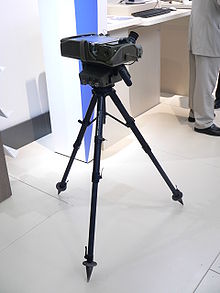Laser designator
It has been suggested that this article be merged into Laser guidance. (Discuss) Proposed since May 2021. |
A laser designator is a laser light source which is used to designate a target. Laser designators provide targeting for laser-guided bombs, missiles, or precision artillery munitions, such as the Paveway series of bombs, AGM-114 Hellfire, or the M712 Copperhead round, respectively.
When a target is marked by a designator, the beam is invisible and does not shine continuously. Instead, a series of coded pulses of laser light are fired. These signals bounce off the target into the sky, where they are detected by the seeker on the laser-guided munition, which steers itself towards the centre of the reflected signal. Unless the people being targeted possess laser detection equipment or can hear aircraft overhead, it is extremely difficult for them to determine whether they are being marked. Laser designators work best in clear atmospheric conditions. Cloud cover, rain or smoke can make reliable designation of targets difficult or impossible unless a simulation is accessible through available ground data.
Deployment[]
Laser designators may be mounted on aircraft, ground vehicles, naval vessels, or handheld.
Airborne[]
The U.S. Air Force selected the Lockheed Martin's Sniper Advanced Targeting Pod (ATP) in 2004. It equipped multiple USAF platforms such as the F-16, F-15E, B-1, B-52, and A-10C. It also operates on multiple international fighter platforms. The U.S. Navy currently employ LITENING and ATFLIR targeting pods on a variety of strike aircraft.[1] The Litening II is widely used by many other of the world's air forces. The United Kingdom's Royal Air Force use the Litening III system and the French use the ,[2][circular reference] Damocles and ATLIS II.
Ground-based[]

U.S. Air Force Joint Terminal Air Controllers and Marine Corps Forward Air Controllers typically employ a lightweight device, such as the AN/PED-1 Lightweight Laser Designator Rangefinder (LLDR), permitting them to designate targets for Close Air Support aircraft flying overhead and in close proximity to friendly forces.[3] Northrop Grumman's LLDR, using an eye-safe laser wavelength, recognizes targets, finds the range to a target, and fixes target locations for laser-guided, GPS-guided, and conventional munitions. This lightweight, interoperable system uniquely provides range finding and targeting information to other digital battlefield systems[4] allowing the system to provide targeting information for non-guided munitions, or when laser designation is unreliable due to battlefield conditions. Pakistan Army uses home made laser designator LDR-4.[5]
See also[]
- Guidance system
- Laser sight
- List of laser articles
- List of military electronics of the United States
- Targeting pods
- AN/PEQ-1 SOFLAM
References[]
- ^ "Fact Sheet - LITENING II". 24 June 2003. Archived from the original on 24 June 2003.CS1 maint: bot: original URL status unknown (link)
- ^ fr:Pod Talios
- ^ "AN/PED-1 Lightweight Laser Designator Rangefinder (LLDR)".
- ^ "Photo Release -- U.S. Army Awards Northrop Grumman Lightweight Laser Designator Rangefinders Delivery Order Valued at $142.7 Million (NYSE:NOC)". Archived from the original on 2010-03-25.
- ^ "LDR". gids.com.pk.
Further reading[]
| Wikimedia Commons has media related to Laser designators. |
- Lightweight Laser Designator Rangefinder, Northrop Grumman
- Laser ranging
- Missile guidance
- Targeting (warfare)


